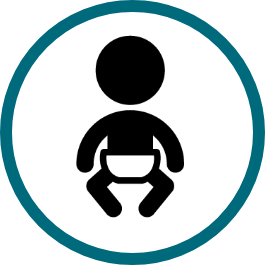Essential newborn care within the first week of life could reduce neonatal mortality by 50%. 1Can available interventions end preventable deaths in mothers, newborn babies, and stillbirths, and at what cost?
The Lancet
Zulfi qar A Bhutta, Jai K Das, Rajiv Bahl, Joy E Lawn, Rehana A Salam, Vinod K Paul, M Jeeva Sankar, Hannah Blencowe, Arjumand Rizvi, Victoria B Chou, Neff Walker
2014 This is a one-time set of behaviors that begin during labor and delivery.

Essential Newborn Care
Caregivers provide essential newborn care immediately after birth
Key Points from Global Research
- Equipping providers or traditional birth attendants with the correct knowledge, technical skills and supervision can allow them to carry out essential newborn care practices.
- Working with traditional birth attendants and community leaders to normalize recommended practices that sometimes contradict traditional ones can ensure women and their families are willing to do them.
- Providing pregnant women with clean birth and newborn-care kits can equip them to follow essential newborn care practices, even if they deliver at home.
Behavior Profile Sample: Essential Newborn Care
A Behavior Profile is a summary analysis of each behavior. This sample draws from global evidence and illustrates the result of using the Create Behavior Profiles Tool to analyze factors, supporting actors and strategies and to ensure logical pathways exist between strategies proposed and factors related to the practice of the behavior. This sample may be used as a starting point or reference for creating Behavior Profiles.
| Improve maternal and child survival | |
|
Caregivers provide essential newborn care immediately after birth Indicator: Among last-born children born in the 2 years preceding the survey, percentage who started breastfeeding within 1 hour of delivery
Indicator: Percentage of live births in the three years preceding the survey delivered at a health facility. The proxy indicator is based on the assumption that newborns are more likely to receive the elements of essential newborn care if they are born in a health facility. |
Behavior Analysis |
Strategy | ||
|---|---|---|---|
STEPSWhat steps are needed to practice this behavior?
Click on any box |
FACTORSWhat factors may prevent or support practice of this behavior? These should be analyzed for each country context.StructuralAccessibility: Caregivers cannot always provide essential newborn care for babies born at home because households often lack key supplies including antiseptic for cord cleansing Service Provider Competencies: Caregivers cannot always provide essential newborn care occurs because they feel providers do not always know or follow the relevant protocols SocialFamily and Community Support: Caregivers cannot always provide essential newborn care for babies born at home because supporting family members or birth attendants do not know the appropriate care to give Norms: Caregivers cannot always provide essential newborn care because many cultures have specific rituals or beliefs that dictate care of newborns (i.e. separation of mother and baby, immediate cleaning using herbs or other agents on or around the umbilical cord) InternalAttitudes and Beliefs: Caregivers access essential newborn care immediately after birth because they want a healthy baby. Knowledge: Caregivers cannot provide essential newborn care immediately after birth as they do not know what to do as they did not give birth in a health facility Knowledge: Caregivers do not provide essential newborn care because they are unaware that many babies born not breathing can be easily resuscitated |
SUPPORTING ACTORS AND ACTIONSWho must support the practice of this behavior?InstitutionalPolicymakers: Ensure availability and distribution of clean birthing kits to mothers during antenatal care visits Policymakers: Create, disseminate and enforce national guidelines for newborn care Providers: Offer counseling on newborn care practices to pregnant women during antenatal care visits and to new mothers before discharge and during postpartum visits Providers: Follow protocols for newborn care practices HouseholdFamily Members: Learn newborn care practices and support new mothers in implementing them |
POSSIBLE PROGRAM STRATEGIESHow might we focus our efforts based on this analysis?Enabling EnvironmentPolicies and Governance: Clarify and enforce clear newborn care guidelines in health facilities Policies and Governance: Ensure community health agents and Traditional Birth Attendants (TBAs) are included in awareness raising on newborn care practices Systems, Products and ServicesProducts and Technology: Provide clean delivery and newborn care kits to mothers during ANC visits (including antiseptic) Quality Improvement: Ensure health providers understand and follow national guidelines for newborn care including newborn resuscitation and counsel new mothers on take-home actions Demand and UseCommunication: Create pregnancy and new mother support groups to discuss and normalize all aspects of newborn care Skills Building: Offer training to pregnant women and their families on newborn care steps |
Global Status of Accelerator Behavior
Indicator: Percentage of live births in the three years preceding the survey delivered at a health facility. The proxy indicator is based on the assumption that newborns are more likely to receive the elements of essential newborn care if they are born in a health facility.
The DHS Program Indicator Data API, The Demographic and Health Surveys (DHS) Program


 The Manoff Group was acquired by JSI in 2022.
The Manoff Group was acquired by JSI in 2022.